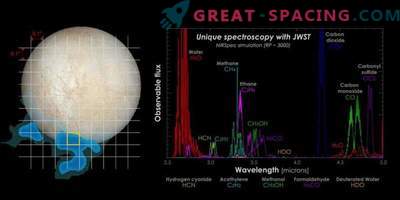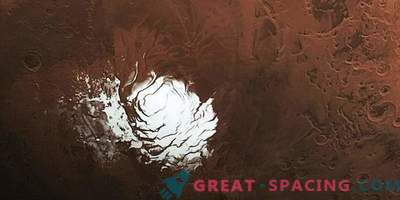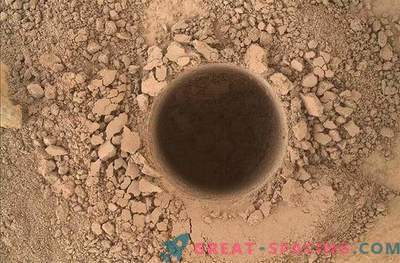
A lidar system used to detect airborne biological hazards on Earth can help NASA search for extraterrestrial life on Mars and elsewhere in the solar system.
Back in the 2000s, when Branimir Blagojevich developed a sensor for the military to detect biological hazards in the air, he had no idea that his technology could later be used to search for extraterrestrial life.
His original work focused on the use of the new lidar (Light Detection and Ranging - light distance meter) and was based on the same principles that are used in the radar. But instead of radio waves, a lidar uses a laser beam to detect objects and measure the distance to the target. Therefore, it is often called “light radar”.
Blagojevich, now a NASA technologist at the Goddard Space Flight Center in Maryland, realized that technology based on searching for toxins and pathogens in the air could be used outside the Earth and could even contribute to NASA’s life search mission (which was or is ) on Mars.
“If life existed on Mars in the past, then with the help of such a tool we can detect it,” said Blagojevich.
Now, any mission aimed at Mars is very limited in its search for life (past or present). For example, the Martian science lab of the Curiosity rover can take a sample of regolith (dusty powdery “soil” covering the Red Planet), hoping that there is biological chemistry in a small amount of ground rock. But physical contact with any material being analyzed is a problem. There is a risk of contaminating the “intact” sample with terrestrial substances, which will potentially distort test results In addition, it is a slow and laborious process: the robot must come into place, collect and analyze samples. This means that very few samples can be taken from any given location. It may be that the sample analyzed by the tools of the rover will be completely sterile. But just a few meters from the site can be dirt with organic chemistry. And without the knowledge of the robot or its earth controllers, we would never have known about it.
For Blagojevich, it looks like we are looking for a needle in a haystack. But the situation is much worse, because we do not even know where this haystack is.
So how to narrow the chances of finding biological material on Mars? One way may be to use his Bio-Indicator Lidar Instrument, or simply “BILI”.

Mars is no stranger to lasers. Curiosity is now using ChemCam to blast rocks into a laser. At the same time, its sensors can study steam in order to decipher its chemical composition. However, Martian breeds will be protected from BILI.
Blagojevich, working with NASA planetary scientists Melissa Trainer, Alexander Pavlov and Melissa Floyd, hopes to install a lidar system for the future rover. It will work in the same way as ChemCam on Curiosity. But he is not interested in geological features, but in particles in the Martian atmosphere. During the mission, the rover will scan the environment for dust plumes. After detecting, probably above a hard-to-reach slope, he would have shot ultraviolet lasers into dust.
When a laser beam hits individual particles of dust, it will cause them to produce light in response. This phenomenon is called flowering. The light from these fluorescent particles can then be measured and shown what chemicals it consists of. If there is any organic matter (bioindicators) in the dust, BILI can decode its signal. And the main thing is that the whole process is carried out remotely, possibly hundreds of kilometers from the rover. This means that you can scan a huge area around the rover and calculate the pollution and organic chemistry, which greatly simplifies the research.
“This will increase the likelihood of finding life by moving mechanisms on the Martian surface,” said Blagojevich.
Mars bets are obvious, and there is an opportunity to see rovers with BILI technology for scanning dusty red jets. But can this technology be used to hunt for life elsewhere in the solar system?
“Outside of Mars, we made some simulated calculations on whether this tool can work on frozen worlds such as Enceladus or Europe,” said Blagojevich.
Enceladus is one of the mysterious satellites of Saturn, which has a thick ice shell around the subsurface ocean. Due to tidal interaction with Saturn, Enceladus produces heat in its core, which contains groundwater in a liquid state. His ocean is of great interest to astrobiologists, because, by analogy with the Earth, liquid water means life.
Internal heating and constant stress on the ice shell cause liquid water to erupt on the lunar surface, as when opening a cap on a bottle of Coke. A huge amount of steam is lost in space, creating a train. If extraterrestrial biology is present in this water, it is also released into space.

NASA’s Cassini mission used the sensors on board to “try” these jets as they flew past (pictured above), but a detailed analysis is needed. Is it possible to install BILI on the Saturn flyby mission to shoot a laser into the plume and see if there are organic chemicals? “It will be quite a challenge. The fact is that the water jets on Enceladus have a very low density compared to dust particles in the Martian air, ”said Blagojevich. Therefore, in order to detect something a spacecraft would have to fly at a distance of 50 km from the surface of the moon and the laser must be in the range of 1W to detect any flowering.
“It is possible, but it requires a more powerful ultraviolet laser, which can become a reality for future flight missions, or it cannot,” he added.
Regarding Europe, Blagojevich warns that, without having obvious jets with long duration, the use of the lidar system will depend on whether there are any existing aerosols near its surface. Europe, compared with Enceladus, wins in the matter of finding life. Some optimistic predictions suggest that you can even meet a multicellular life there.
Since we know chemistry from the inside of the lunar cycles (through active ice tectonics), if there is biology in the oceans of Europe, then evidence can be found on the icy surface. And if there is any mechanism forcing these organic chemicals to rise above the ice, then perhaps BILI can be used to uncover these secrets.











































